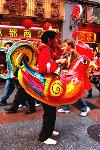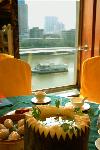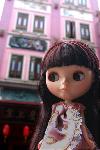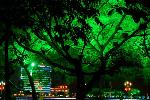- Getting around Lijiang. Dont stay in the Old Towns more than 2 days, there is nothing to do. KRISS Oct 9, 2013 05:46
- 2013 Beijing Temple Fair BENNYLAU Feb 26, 2013 03:29
- Malaysian traveling from KUL - LAX vis Shanghai PVG ZATI_DY Jan 3, 2013 20:15
Why should I bypass Guangzhou…?
- Views: 11972
- |Vote: 13 1
- |Add to Favorites
- |Recommend to Friends
The Cantonese talk often about Xiguan (西关), and I was told that Xiguan represents the integrity of the Cantonese culture. But there is even no district, or place of this name that I could endeavour to find and locate in my Guangzhou map. Yet even in the first encounters, if you care to quest for it, any Guangzhou resident would show your way, with much enthusiasm, to Xiguan, or the West Gate (but why should a Chinese city with the historical and cultural weights alike Nanjing, Xi’an and Beijing be without a city wall and where should there be a gate? ... )
I immediately found out that it referred, more or less, to the core of the district of Liwan, or the Bay of Lychees; yet this is so vaguely and as indefinable as those seeming names of places like “Jiangnan” (south of the river), or “Lingnan” (south of the ranges) that it perhaps just encompasses geographically the lined up quaint, old balconied shophouses and mansions, on a few famous “Pu” and “Lu” - avenues and alleys, or else the many Zhonghua Laozihao - old brand names and shops … But then I wonder there must be something more than that…but what is it?
Looking at the enigmatic double happiness sandalwood cabinet from Hollywood Road now sitting in my house, undoubtedly part of the dowry of a certain ancient grandmother (in her youth a Xiguan Xiaojie?), I am confused, and it occurs to me that Xiguan embraces, in essence, certain intangible, flamboyant lifestyles, and what if should I approach it and open one by one its treasure chest of drawers, would it unfold one after another the collective memories of what have been incarnated in everything Cantonese?
YUMCHA and DIMSUM 《一盅两件》
Arriving at the Guangzhou East railway station in mid morning, we headed into the heart of Xiguan – the Shangxia Jiu Shophouses Pedestrian streets area, off the Chengzhoulu metro station. It was not so much because of my appetite for discovering Xiguan than that it was the perfect timing to join the “yumcha” party of the Guangzhou residents, as those streets also house the oldest culinary restaurants of the Cantonese cuisine.
Yumcha, tea drinking, is still an early breakfast of the elderly, and a pastime of the oldies..., accompanied by their bouncing, chirping birdies in well carved wooden cages, to start the day with the tasting of the dimsum, or little delicacies, in a sip of fragrant or Kungfu tea, and at the same time being entertained by the Cantonese opera singing. But only the Datong restaurant preserves the tradition.
Today yumcha becomes often a brunch, of always dimsum and tea, maybe combined with a few fried noodles or rice dishes. It can be occasions of family day out, weekend reunions, meeting of friends, dating, business appointments, or just exchanges of news in town across neighbouring tables... In any case it is as well a place of chatting, and is very loud. But the whole idea is a very delightful lifestyle.
The earliest dimsum was documented as small dishes of delicacies, of sweet pastries, in the imperial banquet of the Tang Dynasty. Another assumption was its origin from teahouses at crossroads, serving snacks to weary en route silk road traders.
It is thus in any case not an invention of the Cantonese; but the Cantonese has developed it into today’s sublime culinary tastes and artistry - that could be expressed into some 2,000 varieties, usually being served in up to 100 kinds, in different wrappings and combination of fillings, all with fresh ingredients, and made with a lot of skills, being steamed, deep-fried among other cooking methods; in a given day in larger restaurants, and it is being achieved in such repercussions that the Dimsum is known worldwide and sometimes stereotypes the Chinese cuisine, through the Cantonese yumcha..
The Fabulous Culinary Five 《食在广州》
The oldest restaurants are the fabulous five remainders - Guangzhou Jiujia (Nº 2 Wenchang Nan Lu,), Lianxiang Lou (Nº. 67 Di Shi Fu Lu), Taotaoju (Nº. 20 Di Shi Fu Lu), Panxi (nº 151 Longjin Xi Lu) and Datong (nº 63 Yanjiang XI Lu).
We were at Guangzhou restaurant, and the old restaurant at Shangxia Jia still served the dimsum by a lady with a heated cart, shouting the varieties of the dimsum in piles of bamboo baskets in hot. fragrant steam.
We ordered to our heart’s delights, as what Dimsum literrally mean in Chinese.
My favourite is Har Gau, known to some as « ravioli aux crevettes », a crystalline white face of crescent shaped rice pastry, and as the steam unveils, as if blush becomes her, the rosy taints of shrimps and hidden, minced asparagus shoots fillings reveal themselves– just a touch of these fresh ingredients intently blended, and almost short of seasonings than a pinch of fleur de sel, being cooked à la vapeur in the steamer basket, all of which retain the tastes of the food as fresh and as original, only seasoned naturally by the juices of the food from steaming, a principle that, in my opinion, makes the Cantonese cuisine among the best cooking in the world.
The Cantonese love to drink tea and eat alfresco in a garden, amidst “bird chirping and floral fragrance” as a saying goes, the delightful pagoda, lotus ponds and colonnades with weepy willows and sturdy bamboos. The Panxi Restaurant, historical relic site of the Western Han Dynasty Nanyue King’s concubine palace, the largest garden-styled restaurant in Guangdong, and probably in China, is the one to go… but it was under "renovation”; and a Guangzhou resident told us that hopefully it will reopen its gate one day… But that is a serious news, isn’t it… another trace of footstep back to the intangible Xiguan lost.¹
An alternative of the garden style is the younger Nanyuan (nº 142 Qianjin Lu, Haizhu District), but it does not belong to the Xiguan era.
In my opinion I rate the Datong Restaurant, overlooking the Pearl River on Yanjiang Xi Lu, offering the best culinary tastes, and at a reasonable price. Its specialty is ‘Red’ crispy chicken (当红炸子鸡), a term borrowed to make allusion of the “redness”, or being deep fried to the optimal golden state, to the popularity, and with an undertone of luck, of some charismatic persons, like the flamboyant Xiguan people.
______
¹ The Panxi Restaurant has been reopened after renovation, and is in fact rated best in Guangzhou by the author
XIGUAN DAWU 《古屋风情》
Old Architecture of Xiguan (西关古老大屋群)
Strolling down the bustling commercial Shangxia Jia Lu and Dishifu Lu, we were still interested in the vernacular, terraced, two to four storey shophouses, with “Qi Lou” or pillars in front of them, attaching the store to the second storey from the pavement.
The shophouses burgeon on both sides of the pedestrian road, winding as the direction of the road leads, and we were led to Enning Lu, where the century-old shops and commercial boutiques, colourful Manchu stain-glassed windows and Shanshui scenery façade carvings are replaced by the same styled but worn out buildings - on street level, I saw elders with bamboo fan peeping from the sliding timber door, women washing vegetables outside shops of old fashioned trades such as copper Chinese fondu casseroles and woks, barbers, shoe-menders, tailors, Cantonese opera costumes, herbal tea stalls…; upstairs were domestic display of untended plants penetrating walls, crevices, together with thriving Chinese orchids, birds in hanging cages, and large scale laundry on bamboos.
We stopped at nº 177 Enning Road, and visited the Hall of Ba He Hui Guan (八和会馆) , the home of Cantonese opera. The intermittent echoes of the apprenticing artists’ rudiments from unpermitted halls, in accomplice with the dim lamplight under the high ceilings, the lingering of an ‘ancient’ community in the hall of antique furnishings, display of dramatic costumes and exotic Chinese instruments, and the stale air behind the timber bars of the sliding façade door all made the time unreal there, and some intangible something were haunting there….
In an alley we turned into from Dishier Fu on Enning Lu in search of the residence site of the father of Chinese railway, Zhan Tianyou (with an interesting backyard of a 'zig-zag' rail section, the design of Zhan), we were reunited into the mundane life of the local residents who occupy nowadays these Xiguan houses, of which we had a glimpse later on the way back at Baohua Lu, being invited by a woman waiting for her turn at the mahjong table, as she had unexpected guests that day that made up an odd number for the 4-party battle..
This kind of prosaic Xiguan architecture can be seen in Enning Lu, Longjin Xi Lu, Bao Yuan Lu, Bao Hua Lu, Beijing Lu Commercial Street, Zhongshan Wu Lu and Hui Fu Lu, and a displayed Xiguan house, at the Liwan Museum of Folk Customs, located in the antique district at nº 84, Longjin Xi Lu / Feng Yuan Bei Lu (Metro station: Changzhou Lu; Open daily except Mondays 8:30 - 11:30 & 14:00 - 17:00; entrance fee RMB8; Tel: 020-8193 9917).
If you go for the poetry, the Lingnan, or Cantonese architectures are exemplified in Chen Ancestral Hall and Clan Academy, also in Liwan district of Guangzhou, or Baomo Garden, at Zini Village near Shawan town of Panyu, the suburb of Guangzhou.
Chen Ancestral Hall 《古祠流芳》
(陈家祠)
Now the Guangdong Folk Arts Museum, the Ancestral Hall of the Chen clan (it was said that the surname Chan prevails in Guangdong and Lee the ‘world’!) was built in the sixteenth year (1890) of Guangxu Emperor of the Qing Dynasty when a distinguished scholar Chen won a third place in the highest imperial examination and was conferred a distinguished office title. Mr. Chen, in honour of the ancestors, raised the fund from the Chen kinship in Guangdong and abroad to build the clan temple which mainly served as an academy for scholars of the Chen families, in 72 counties, very large family indeed, of the Guangdong Province.
The compound is a confined complex, greeted by a pair of huge stone drums and a door with best artistic rated paintings of door guardian gods, and consisting of nine halls, six courtyards and nineteen houses connected by corridors. It is a beautiful architecture with an academic ambience, symmetrical structures and gardens, and the all sorts of folk architectural and decorative arts, famous for its "Three Carvings" (stone, wood and brick carvings), "Three sculptures" (ceramic sculpture, clay sculpture and colorful sculpture) and "One cast" (cast iron). It is rated the best of all the clan temples of this genre in Lingnan, in the south, perhaps, in my opinion, rivaling the Ancestral Temple of Foshan.
Metro Station: Chen jiaci
Entrance fee: RMB10
Opening hours: 8:30-17:30
Baomo Garden 《宝墨怡情》
Baomo Garden (宝墨园) is a fine representation of the Lingnan architecture, Xiguan house, traditional gardening arts of South China, and water town scenery in the Pearl River Delta
Once inside, exotic buildings, gardens, hills, lakes and bridges are found - a place that reveals interplay between nature's art and man-made art in forms of sculptures and edifices, which boast intricate clay, porcelain, brick, wood and stone carving.
To get there:
Boamo Yuan, Zini Village near Shawan town of Panyu, the suburb of Guangzhou. (宝墨园番禺沙湾镇紫坭村.)
Within Panyu: Bus line 12
From Guangzhou: Guangzhou Coach Station (opposite to the west Train Station and Provincial Coach Station)-Baomo Garden coach, departing at 8:00, 9:10, 10:20, 11:50, 14:20 and 15:40
Entrance fee: 30 RMB
CONGEE ON A BOAT 《荔湾渔唱》
The downtown Guangzhou takes on a circular shape and is surrounded by the Pearl River which must have served the natural function of a city wall and that should account for its absence. The Pearl River, named after a huge, rounded shaped, smooth boulder from the river bed, “sea pearl”, diverts into three off Huangsha area where the Pearl River cruise can be boarded at the Long Dyke pier off the century-old department store Nanfong Building, and some steps further is the Shamian Island.
In Xiguan days, Xiguan people entertained guests on board of “Zi Dong” boat (紫洞舫) that could accommodate several tables of banquets serving freshly caught seafood, again very delightful in the midst of white lotus and ripened lychees on summer nights. The Bay would be packed with an array of the little boats (紫洞艇) hosted by beautiful Xiaojie in tight Qi-pao or banner dress and veiled shawl offering companionship, discussions, singing, Pipa or Zheng music, .wine and banquet.
Today a taste of this kind of floating clubbing can be revisited at a water garden-styled restaurant, Tang Lee Yuan, inside Liwan Lake park, where a large boat of banquet rooms not unlike the Zi Dong boat idea and a row of small boats are dining tables, to whcih the food is paddled by a waitress, and a separate boat serves as kitchen making a famous local dish, the Liwan boat congee (荔湾艇仔粥), a porridge fishermen in the old days prepared with fresh seafood and the fabulous thousand-year egg . The restaurant also serves a full Cantonese cuisine menu for the main courses, even with some rare dishes that might put off travelers, and the food is good. Whether on board of a boat, laid back at the terrace, or secluded in the large banquet boat, every guest may enjoy the ambience and view from dusk tainting the water until lighting up of the lantern lights till after midnight.
Tang Lee Yuan (唐荔园), Ru Yi Fang, Huangsha Dadao (荔湾湖公园黄沙大道如意坊) Tel 8181-8002,
XIGUAN MEETING WEST《花样年华》
Colonial styled Architecture of Shamian(沙面建筑群)
Along the Pearl River, it is worth a circular stroll on the Shamian Island, comprising of Shamian North Street, South Street and in between a square, of European styled blocks, some being offices, cafes and restaurants, bridal shops, and hotels, and each being a former foreign consulate, bank or enterprise establishment.
A green block not far away from a building of French company offices, is a Starbucks. Catching me by surprise, a superdolfie meet of a dozen local young boys and girls was being held there, posing their gothic best dressed SD against DSLRs with fine lenses. My blythe looked petite, candide but certainly more blithier among them.
Further down the middle square at the juncture of the Church - Our Lady of Lourdes Chapel , brides and grooms were posing dramatically for their best shots.
We also paid visit to the former Banque Indosuez block at n 18 Shamian South Street. The banking hall is transformed into a perfect rendezvous for dates of the locals, somewhat awkwardly called the Darling Coffee Fort.
NIGHTLY PEARL 《珠水夜韵》
Walking on the outskirt of Shamian South Street, or the West Dyke along the Pearl River, we came across some late afternoon swimmers in Sea Pearl!
As the night stole into darkness, we thought we had well skipped the tourist cruise by strolling along the West Dyke, along with the lovers, to enjoy the spectacular neon lights of the high-rise buildings on the opposite bank and their reflections pierced by the shining cruises, then back to darkness, in gentle wind, till reaching the White Swan hotel (nº 1 Shamian South Street). A buffet dinner at the Pearl River side of the lobby could also be a best spot to view the Pearl River night scene if you are into it.
Our evening ended there pleasantly under much impression, and joy, of the gentle “southern” wind that weekend, before we caught the last Canton-Kowloon through train back to where we are, another Pearl city, Hongkong.
THINGS CANTONESE...
« Mountain high, emperor afar », no wonder the Cantonese, among the people in Jiangnan, or south of the Yangzi had traditionally long cultivated their lifestyles of unquestionable pleasure and among other practical things of the daily hassles, a sense of « joy of living ».
And what I have observed here in China, about things Cantonese, or the Lingnan culture, referring to the culture of Guangdong and the nearby provinces in southeastern China, and perhaps inextricably represented at its best by Xiguan, is that it is often juxtaposed, in dialect and every way, to Zhongyuan culture, that of China's northern plains, and the attitudes of the Mandarin and Cantonese speaking people, or Bei Fong Ren (北方人) and Nan Fong Ren(南方人), I also observed, could be at best, bewildered by, almost feeling “exotic” towards each other’s culture and lifestyles.
----------------
Among China's best destinations : ♥ ♥ ♥ (personal rating)
® TheFaerieQueene 2007














 Copyright © 1998-2025 All rights reserved.
Copyright © 1998-2025 All rights reserved.
1.
May 5, 2011 11:39 Reply
KENL8888 said:
Ladies will love Guangzhou especially the bargaining and great variety of things; clothing, shoes, bags, accessories; souvenirs.. indeed, one can start a business back home with all the available stuff..
2.
Mar 16, 2009 06:16 Reply
SNOWHOG said:
We readers, FAERIEQUEENE, benefit from your ignoring of early childhood teachers' admonitions to avoid run-on sentences thereby providing us with poetic prose that creates a sequence of beautiful images in our minds. Thank you.
3.
Feb 4, 2008 06:25 Reply
FAERIEQUEENE said:
Too often i read in the Travel Q&A section travellers posing that question when planning a trip to china… “should I bypass GZ to visit more places en route to the north, how many days worthwhile to spend in GZ”, etc… If you have the same question in mind as I did before exploring the city I hope the review of my trips to the city has highlighted the essence of some of the city’s attractions, and provided some footprints to the Cantonese culture, which is the embodiment of the culture of China ’s south.
4.
Feb 2, 2008 18:43 Reply
CANADAGUY said:
A great review of Guangzhou, but I'm very curious about the title of the article:
'Why should I bypass Guangzhou…?'
I read the review from beginning to end but couldn't find any reason to bypass Guangzhou.
Maybe a more appropriate title would be
'Why you shouldn't bypass Guangzhou'
OR
'Why you shouldn't miss Guangzhou'.
5.
Dec 19, 2007 21:49 Reply
LEONARDO said:
A great review! Practical information and lyrically written. I am immersed in the reverie of "bird chirping and floral fragrance" . What a splendid scene!